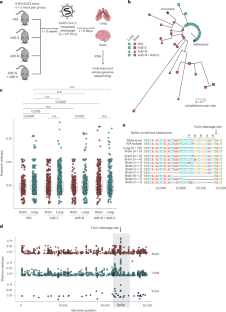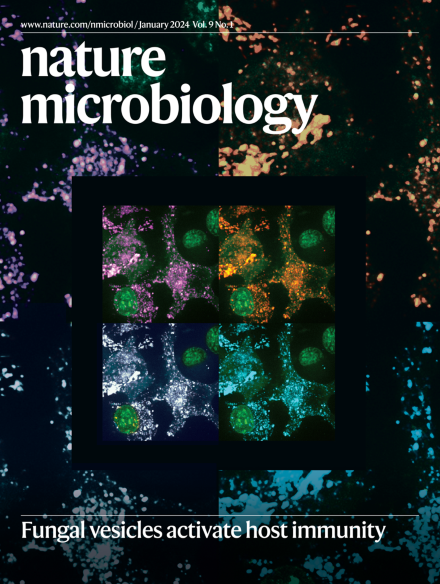SARS-CoV-2 在小鼠中枢神经系统中的进化推动了病毒的多样化
IF 20.5
1区 生物学
Q1 MICROBIOLOGY
引用次数: 0
摘要
2019 年严重冠状病毒病和严重急性呼吸系统综合征冠状病毒 2(SARS-CoV-2)感染的急性后遗症与神经系统并发症有关,这些并发症可能与中枢神经系统(CNS)的直接感染有关,但神经入侵的选择性压力尚不明确。在这里,我们评估了 SARS-CoV-2 在受感染小鼠肺部和中枢神经系统中的进化情况。经鼻内挑战后,在中枢神经系统中观察到的病毒分化程度高于肺部,尖峰呋喃裂解位点(FCS)的突变频率很高。与野生型病毒相比,FCS的缺失可显著降低鼻内挑战后的毒力,降低病毒滴度并减少发病率。然而,颅内接种缺失FCS的病毒足以恢复毒力。颅内接种后,两种病毒都能在肺部建立感染,但从中枢神经系统向肺部扩散需要完整的 FCS。这些数据综合起来表明,FCS 在决定 SARS-CoV-2 的趋向性和分区方面起着关键作用。本文章由计算机程序翻译,如有差异,请以英文原文为准。


Evolution of SARS-CoV-2 in the murine central nervous system drives viral diversification
Severe coronavirus disease 2019 and post-acute sequelae of severe acute respiratory syndrome coronavirus 2 (SARS-CoV-2) infection are associated with neurological complications that may be linked to direct infection of the central nervous system (CNS), but the selective pressures ruling neuroinvasion are poorly defined. Here we assessed SARS-CoV-2 evolution in the lung versus CNS of infected mice. Higher levels of viral divergence were observed in the CNS than the lung after intranasal challenge with a high frequency of mutations in the spike furin cleavage site (FCS). Deletion of the FCS significantly attenuated virulence after intranasal challenge, with lower viral titres and decreased morbidity compared with the wild-type virus. Intracranial inoculation of the FCS-deleted virus, however, was sufficient to restore virulence. After intracranial inoculation, both viruses established infection in the lung, but dissemination from the CNS to the lung required the intact FCS. Cumulatively, these data suggest a critical role for the FCS in determining SARS-CoV-2 tropism and compartmentalization. SARS-CoV-2 replication in the murine lung requires the spike furin cleavage site, which is then lost during divergence in the brain.
求助全文
通过发布文献求助,成功后即可免费获取论文全文。
去求助
来源期刊

Nature Microbiology
Immunology and Microbiology-Microbiology
CiteScore
44.40
自引率
1.10%
发文量
226
期刊介绍:
Nature Microbiology aims to cover a comprehensive range of topics related to microorganisms. This includes:
Evolution: The journal is interested in exploring the evolutionary aspects of microorganisms. This may include research on their genetic diversity, adaptation, and speciation over time.
Physiology and cell biology: Nature Microbiology seeks to understand the functions and characteristics of microorganisms at the cellular and physiological levels. This may involve studying their metabolism, growth patterns, and cellular processes.
Interactions: The journal focuses on the interactions microorganisms have with each other, as well as their interactions with hosts or the environment. This encompasses investigations into microbial communities, symbiotic relationships, and microbial responses to different environments.
Societal significance: Nature Microbiology recognizes the societal impact of microorganisms and welcomes studies that explore their practical applications. This may include research on microbial diseases, biotechnology, or environmental remediation.
In summary, Nature Microbiology is interested in research related to the evolution, physiology and cell biology of microorganisms, their interactions, and their societal relevance.
 求助内容:
求助内容: 应助结果提醒方式:
应助结果提醒方式:


